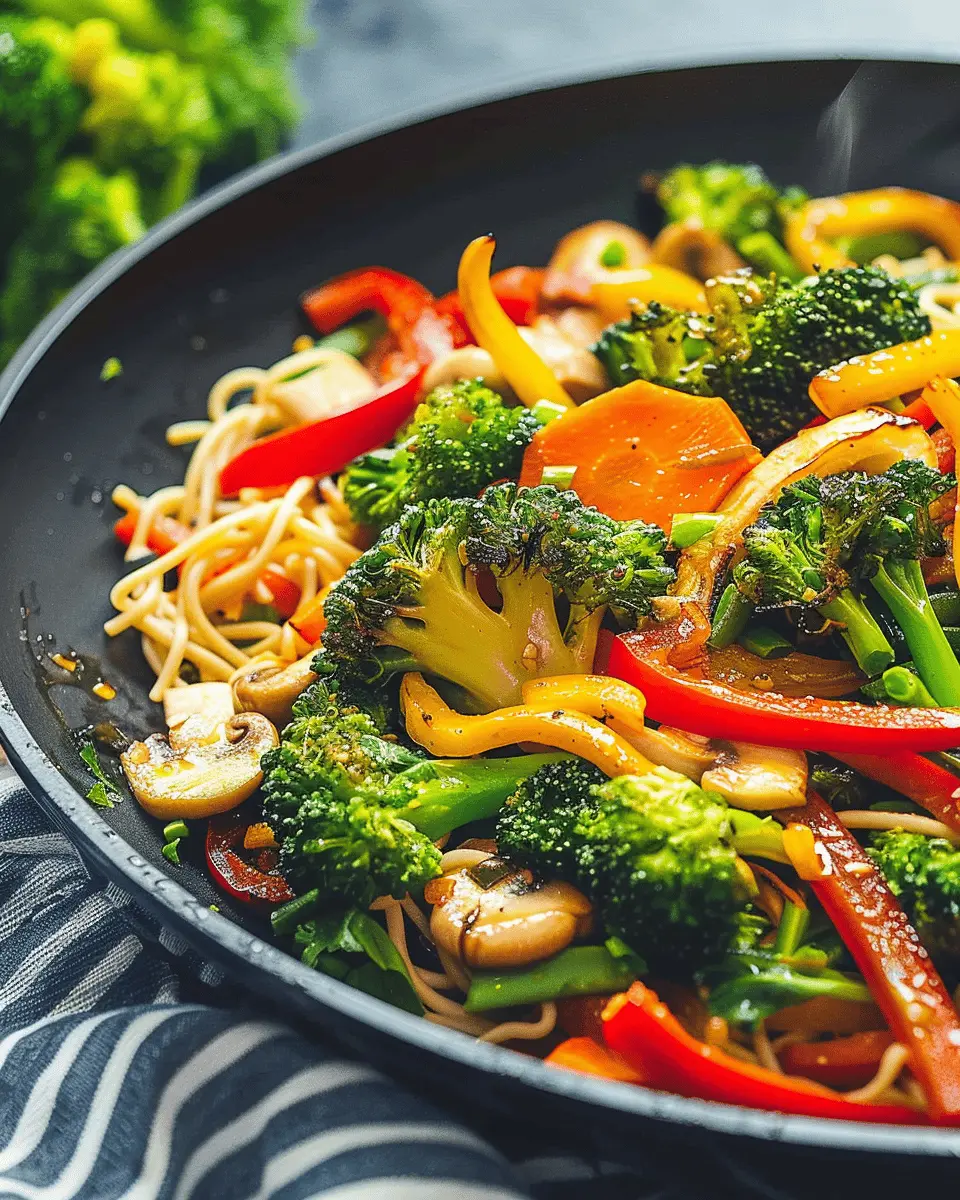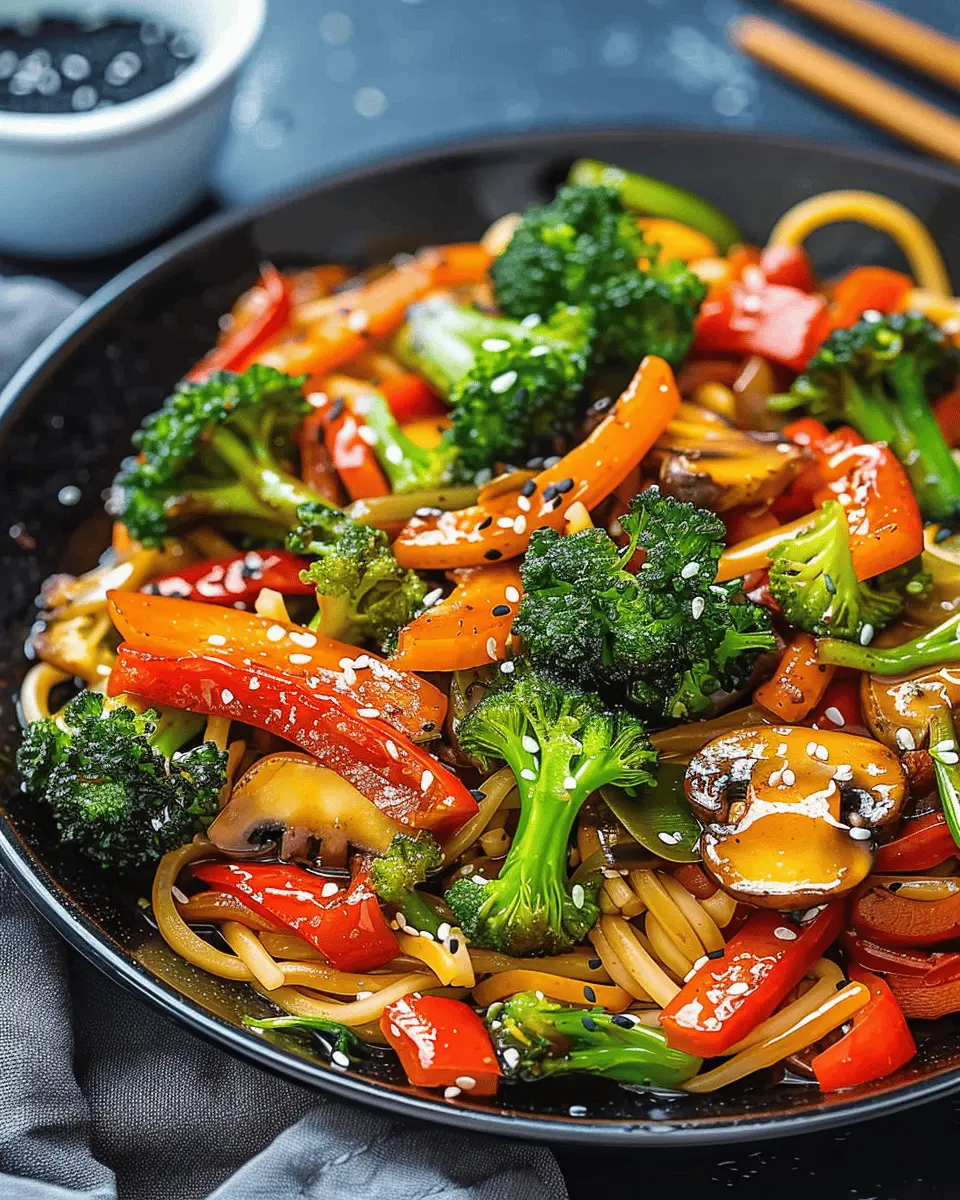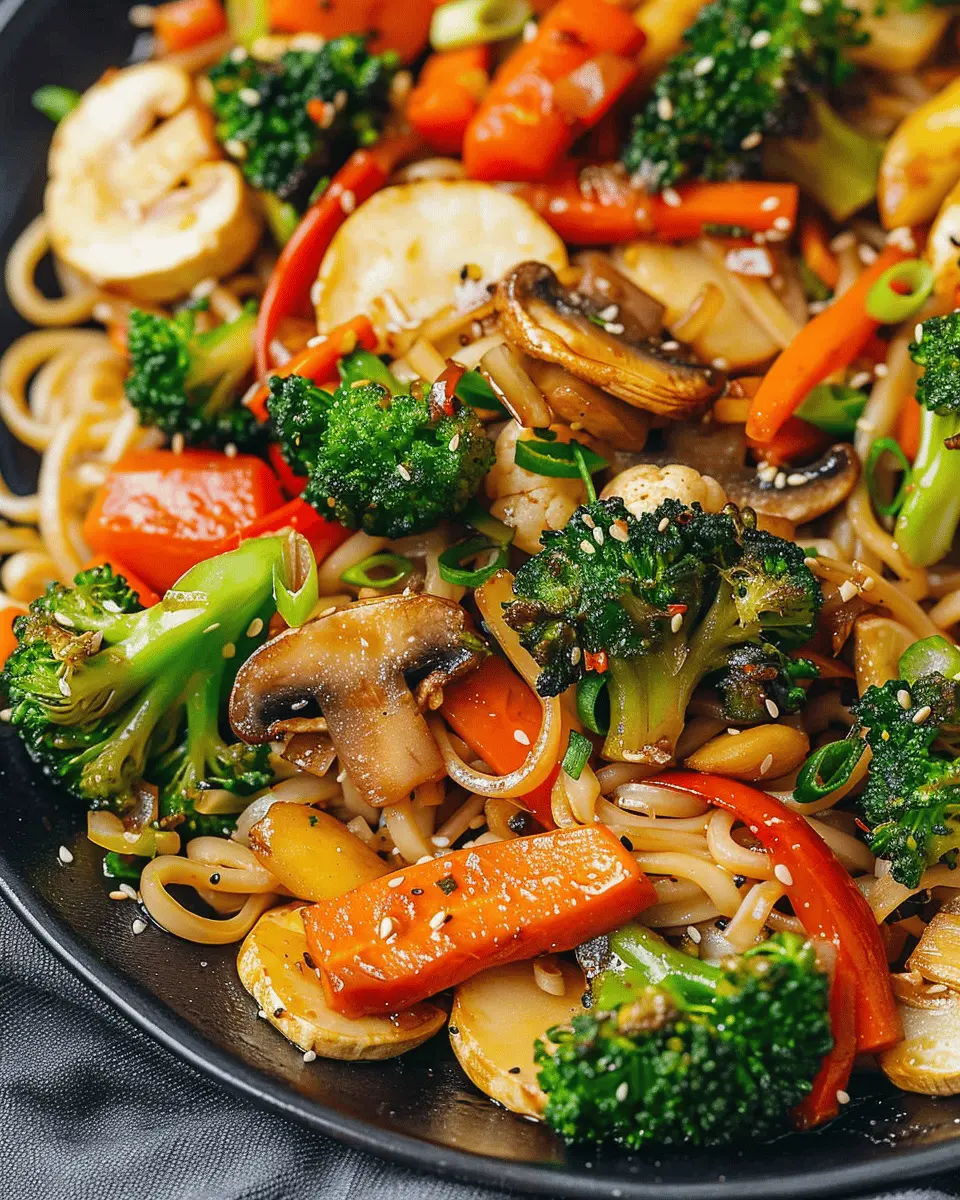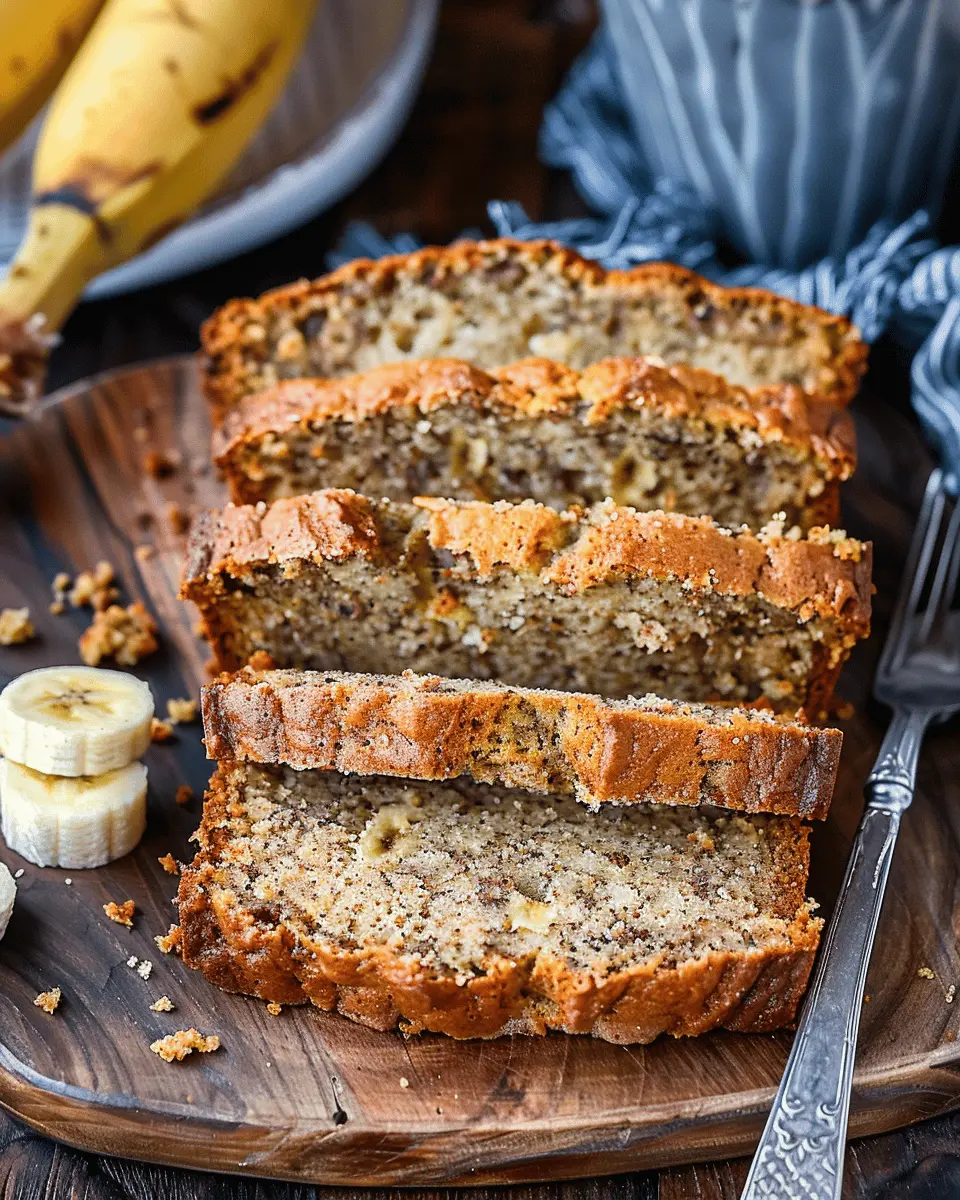Introduction to Vegetable Stir Fry Recipe
When you’re racing against the clock after a long day at work, a vegetable stir fry recipe can be your saving grace. This dish not only lets you whip up a flavorful meal in no time, but it’s also a fantastic choice for those looking to eat more vegetables. With its bright colors and enticing fragrances, a stir fry can transform even the most mundane weeknight into a culinary adventure. Plus, who doesn’t love a meal that’s quick, healthy, and delicious?
Why Choose a Vegetable Stir Fry?
There are several reasons why a vegetable stir fry should be a staple in your kitchen. First and foremost, it’s incredibly versatile. You can use whatever vegetables you have on hand, from bell peppers to broccoli, and even throw in some protein like turkey bacon or chicken ham to amp up the flavor. The beauty of a stir fry is that it encourages creativity. Want to use those leftover greens? Go for it! Missing an ingredient? No worries!
Stir frying is also a nutrient-preserving cooking method. Because the high heat cooks food quickly, it helps retain vitamins and minerals that can be lost during longer cooking times. This means your meal is not only delicious but also packed with essential nutrients. For those who want to explore more about the benefits of stir-frying, check out this insightful article from the American Heart Association.
The Health Benefits of Home-Cooked Meals
Cooking at home has numerous advantages. Not only can you control what goes into your meals, but you can also experiment with healthier cooking oils and fresh ingredients, minimizing processed foods in your diet. According to a study published by the Journal of the Academy of Nutrition and Dietetics, people who cook at home tend to have healthier eating patterns and better overall health outcomes.
Plus, preparing a vegetable stir fry is a great way to nurture positive eating habits. It encourages portion control and allows you to create balanced meals filled with vibrant vegetables. And let’s not forget the satisfaction of cooking something delicious with your own hands. So, why not grab your favorite veggies and jump into this easy-to-follow recipe? You might just find that cooking at home can be a fulfilling and enjoyable experience!

Ingredients for Vegetable Stir Fry Recipe
Creating an unforgettable vegetable stir fry recipe starts with the right blend of flavors and textures. Let’s break down the essential components you’ll need to bring your dish to life!
Essential Ingredients for the Stir Fry Sauce
A great stir fry hinges on a well-balanced sauce. Here’s what to include:
- Soy Sauce: This gives depth and umami flavor. You can opt for low-sodium if you’re watching your salt intake.
- Sesame Oil: Just a splash adds a delightful nutty aroma.
- Garlic and Ginger: These are your flavor powerhouses! Fresh options make a big difference, but you can also use powdered forms in a pinch.
- Rice Vinegar or Lemon Juice: A touch of acidity brightens the entire dish.
Key Vegetables to Include
When it comes to the veggies, variety is key! Here are my top picks that work beautifully together:
- Bell Peppers: They provide sweetness and vibrant color.
- Broccoli: A nutritional powerhouse that holds up well in stir fries.
- Carrots: Their crunch adds texture, plus they’re naturally sweet.
- Snap Peas or Snow Peas: These will give your dish a fresh crunch!
- Zucchini: This versatile veggie soaks up flavors nicely.
Feel free to explore more options based on your preferences or seasonal availability. Embrace creativity; this dish is about using what you love! For tips on seasonal vegetables, check out resources like Eat Seasonal.
Happy cooking!
Preparing the Vegetable Stir Fry
When it comes to quick, healthy meals, there’s nothing quite like a vibrant vegetable stir fry. It’s a flexible option that you can customize based on whatever fresh ingredients you have on hand. In this section, we’ll walk through the steps of creating your delicious vegetable stir fry recipe, ensuring you capture every delightful flavor along the way.
Gather and Prep Your Ingredients
First things first, you’ll want to gather all your ingredients. A well-prepared kitchen can make the cooking process smoother and more enjoyable. Here’s what you’ll need:
- Fresh Vegetables: Think bell peppers, broccoli, snap peas, carrots, and mushrooms. Pick colorful options to brighten your dish!
- Aromatics: Don’t forget garlic and ginger—they’re essential for depth of flavor.
- Protein (optional): If you’re looking to include some protein, consider adding tofu, turkey bacon, or chicken ham.
- Stir Fry Sauce: This is where lots of flavor comes from (more on this in the next step).
Before you start cooking, wash, chop, and prep your vegetables. Cutting your veggies into similar sizes will help them cook evenly. Be sure to check out this guide on chopping techniques to enhance your skills!
Create Your Stir Fry Sauce
Now that you’ve got your ingredients prepped, let’s whip up your stir fry sauce. A simple sauce can make all the difference in terms of flavor. Here’s a favorite mix:
- 3 tablespoons soy sauce or tamari (for a gluten-free option)
- 1 tablespoon sesame oil for a nutty aroma
- 1 tablespoon of rice vinegar for a little tang
- 1 teaspoon of cornstarch mixed with 2 tablespoons of water (this will thicken your sauce)
Combine these ingredients in a small bowl and set it aside. If you prefer a bit of spice, feel free to add chili flakes or a splash of hot sauce to escalate the flavor profile.
Heat the Skillet or Wok
Your cooking vessel makes a world of difference! A wok is traditionally used for stir frying but don’t worry if you don’t have one—any large, heavy-bottom skillet will do the trick. Heat up your skillet or wok over medium-high heat. You want it hot but not smoking. Add about 1 tablespoon of vegetable oil to coat the bottom.
When you feel the heat, it’s time to sauté! Being patient here ensures that your vegetables will have a nice sear, which adds to the stir fry’s overall flavor.
Sauté the Vegetables
Now comes the fun part! Start by adding the heartiest vegetables first. Carrots and broccoli often need a bit more time to soften, while bell peppers and snap peas require less cooking time. Here’s a suggested order:
- Carrots
- Broccoli
- Bell Peppers
- Snap Peas
- Mushrooms
Sauté them for about 5–7 minutes until they are bright and slightly tender but still crisp. Remember to keep stirring to ensure even cooking. Fun fact: Studies show that cooking vegetables quickly at high heat helps retain nutrients, making your stir fry not just tasty, but healthy too!
Add Aromatics and Stir in the Sauce
Once your veggies are almost done, it’s time to add your aromatics—throw in minced garlic and grated ginger. Stir-fry for an additional minute until fragrant. This step really amps up the overall aroma and taste!
Finally, pour in that delicious stir fry sauce you prepared earlier. Stir everything together and allow it to bubble for a minute—the sauce should thicken slightly, coating the veggies beautifully. If adding protein like tofu or turkey bacon, toss it in now to coat it with the flavorful sauce.
And there you go! Your colorful vegetable stir fry is ready to serve. Serve it over steamed rice or noodles, and enjoy a meal that brings nourishment and joy to your table. Stay tuned for the tasting and presentation tips in the next section!

Variations on Vegetable Stir Fry
If you’re looking to spice up your vegetable stir fry recipe, you’ll be thrilled to know there are countless variations you can explore. With a few simple tweaks, you can make a dish that fits any mood or dietary preference.
Adding Protein: Tofu, Chicken, or Shrimp
One of the best ways to enhance your stir fry experience is by incorporating a protein source. Tofu is an excellent vegetarian choice; just press it to remove excess moisture, cube it, and sauté until golden brown. If you’re in the mood for something heartier, consider chicken or shrimp. Both cook quickly and absorb flavors beautifully—try marinating them in soy sauce or garlic for an extra kick!
Chicken or shrimp pairs particularly well with bold sauces like teriyaki or sweet chili. For vegetarian alternatives, this guide on protein sources will steer you in the right direction.
Creative Vegetable Options for Variety
Don’t feel limited to the usual bell peppers and broccoli! Think outside the box with your vegetable stir fry recipe. Consider adding:
- Zucchini: It softens nicely and adds a subtle sweetness.
- Snap peas: They offer a satisfying crunch.
- Eggplant: Adds a unique texture and absorbs sauces well.
You can even introduce seasonality to your stir fry by using whatever vegetables are fresh in your area. Using local produce not only supports your community but also enhances flavor and nutrition.
Try different combinations, and don’t hesitate to experiment—you might discover your new favorite! Remember, the key is to balance color, texture, and flavor for a truly memorable dish. Happy cooking!
Cooking Tips and Notes for Vegetable Stir Fry
Tips for Ensuring Crisp-Tender Veggies
Creating a delightful vegetable stir fry recipe starts with the vegetables themselves. To achieve that satisfying crisp-tender texture, make sure to:
- Cut vegetables uniformly: This ensures even cooking. Aim for bite-sized pieces to cook them quickly while maintaining their crunch.
- High heat is your friend: Preheat your skillet or wok until it’s smoking hot before adding your veggies. This seals in moisture and enhances flavors.
- Stir-fry in batches: Overcrowding your pan will cause steaming rather than frying, so cook in smaller portions to keep things crisp.
How to Achieve the Perfect Sauce Consistency
The sauce can make or break your vegetable stir fry recipe. Here are some tips for that ideal mix:
- Start with a base: Combine soy sauce, garlic, and ginger for depth. For a touch of sweetness, consider adding a splash of orange juice or honey.
- Thickening agents: If you prefer a thicker sauce, mix a teaspoon of cornstarch with a tablespoon of cold water, and add it to the pan towards the end of cooking.
- Adjust to taste: Don’t be afraid to taste and tweak. Add more soy sauce for saltiness or a bit of vinegar for acidity.
For more inspiration, check out this great guide from The Kitchn. Happy cooking!

Serving Suggestions for Vegetable Stir Fry
When it comes to serving your vegetable stir fry recipe, the right accompaniments can elevate your meal from good to fantastic. Here are some ideas to enhance your dining experience!
Ideal Side Dishes to Accompany Your Stir Fry
While the stir fry itself is a vibrant medley of flavors, adding a side can balance the meal beautifully. Consider pairing your dish with:
- Steamed Jasmine or Basmati Rice: The aromatic qualities make a delightful base.
- Quinoa: For a protein-packed alternative that’s gluten-free.
- Noodles: Try rice noodles or whole grain for a satisfying twist.
These options not only complement the stir fry but also absorb the savory sauce, making every bite a treat.
Suggested Garnishes for a Pop of Flavor
Finish off your vegetable stir fry with some garnishes to impress! A sprinkle of:
- Sesame Seeds: Adds a nice crunch and nutty flavor.
- Chopped Green Onions: Provides a fresh, zesty bite.
- Chili Flakes or Fresh Herbs: A little heat can take your dish to the next level.
These tiny touches can make a noteworthy impact, turning an everyday meal into a restaurant-style experience. For more tips on plating and presentation, check out this guide on food styling.
As you enjoy your stir fry, think about what flavors resonate with you. Do these suggestions inspire a new twist on your recipe? Happy cooking!
Time Breakdown for Vegetable Stir Fry
Cooking can be both fun and rewarding, especially with a vibrant vegetable stir fry recipe in play. Here’s a quick breakdown of what to expect in terms of time commitment.
Preparation time
Getting your ingredients prepped will take about 10-15 minutes. This includes washing and chopping your veggies to ensure a colorful assortment. Consider using a sharp knife for efficiency—this can save you precious minutes while keeping your fingers safe!
Cooking time
Once everything is ready, the actual cooking time is quite short—approximately 10 minutes. A fast heat on your stovetop allows those flavors to meld perfectly, making the most of your fresh ingredients in no time.
Total time
In total, expect to spend about 20-25 minutes from start to finish. Perfect for busy young professionals looking to whip up something healthy and delicious without sacrificing too much time!
For more tips on veggie preparations, check out this informative guide on different vegetable varieties. Happy cooking!
Nutritional Facts for Vegetable Stir Fry
Caloric content
When it comes to a vegetable stir fry recipe, one of the biggest perks is the low caloric content! A typical serving, loaded with vibrant veggies, averages around 200-300 calories. This makes it an excellent choice for those looking to enjoy a filling meal without the guilt. Plus, the variety of vegetables means you’re not just counting calories; you’re also fueling your body with goodness.
Key vitamins and minerals
A colorful array of vegetables provides essential vitamins and minerals. For instance, broccoli and bell peppers are packed with Vitamin C, while carrots offer a splendid dose of Vitamin A. To learn more about the benefits of these nutrients, check out resources from Healthline.
Protein content
Although vegetables are often low in protein, adding a source like sliced chicken or turkey bacon can boost this vegetable stir fry recipe significantly. Depending on your protein choice, a serving can provide around 15-25 grams of protein, contributing to muscle health and satiety. So you can maintain a balanced and fulfilling meal without compromising on flavor!
FAQs about Vegetable Stir Fry
Can I customize the vegetables?
Absolutely! One of the best things about any vegetable stir fry recipe is its flexibility. Feel free to mix and match your favorite vegetables. Whether you prefer vibrant bell peppers, crisp broccoli, tender snap peas, or even seasonal veggies like asparagus, the choice is yours. Just keep in mind that different veggies have varying cooking times. For instance, carrots typically take longer than leafy greens, so add them early in the process for the best texture.
What can I use instead of soy sauce?
If you’re looking for a soy-free option, there are several great alternatives. Consider using tamari, which is a gluten-free sauce made from fermented soybeans but doesn’t contain wheat. Coconut aminos are another excellent substitute, providing a slightly sweeter flavor with lower sodium. If you enjoy experimenting, a splash of teriyaki sauce or homemade vegetable broth can add a delightful zing to your stir fry!
How can I store leftovers?
Leftover vegetable stir fry can be stored in the fridge for up to three days. Just make sure to let it cool down before placing it in an airtight container. If you anticipate having leftovers, it’s smart to separate cooked veggies from the sauce to maintain their crispiness. When reheating, do it gently on the stovetop or in the microwave; that way, you’ll revive the freshness of your dish!
For additional insights on cooking techniques and ingredient options, check out resources from Fine Cooking or Bon Appétit. Cooking doesn’t have to be complicated—get creative and enjoy your culinary adventure!
Conclusion on Vegetable Stir Fry Recipe
Cooking at home can be an enjoyable adventure, so why not embrace it with this vegetable stir fry recipe? Experimentation is the key to finding what you love! Feel free to mix different veggies or proteins, like Turkey Bacon or Chicken Ham, to make it your own.
The colorful combinations not only taste great but also contribute to a balanced diet. Homemade meals can be both nutritious and delicious, perfect for busy young professionals. For more inspiration, check out resources like the American Heart Association or EatingWell. Enjoy the process, and happy cooking!
PrintVegetable Stir Fry Recipe: Easy, Flavor-Packed Delight for All
This Vegetable Stir Fry Recipe is a quick and delicious way to get your daily dose of veggies. It’s simple enough for a weeknight dinner and packed with flavor!
- Prep Time: 10 minutes
- Cook Time: 10 minutes
- Total Time: 20 minutes
- Yield: 4 servings 1x
- Category: Main Dish
- Method: Stir Frying
- Cuisine: Asian
- Diet: Vegan
Ingredients
- 1 tablespoon vegetable oil
- 2 cups mixed vegetables (broccoli, bell peppers, carrots)
- 2 cloves garlic, minced
- 2 tablespoons soy sauce
- 1 teaspoon sesame oil
- 1 teaspoon ginger, grated
- 1 tablespoon sesame seeds
Instructions
- Heat the vegetable oil in a large skillet over medium heat.
- Add the mixed vegetables and stir-fry for about 5 minutes.
- Stir in the garlic, ginger, soy sauce, and sesame oil. Cook for another 2-3 minutes.
- Sprinkle with sesame seeds before serving.
Notes
- Customize the veggies based on your preference.
- Add protein like tofu or chicken for a heartier meal.
Nutrition
- Serving Size: 1 serving
- Calories: 200
- Sugar: 3g
- Sodium: 400mg
- Fat: 10g
- Saturated Fat: 1g
- Unsaturated Fat: 7g
- Trans Fat: 0g
- Carbohydrates: 25g
- Fiber: 5g
- Protein: 5g
- Cholesterol: 0mg
Keywords: vegetable, stir fry, quick recipe, healthy












